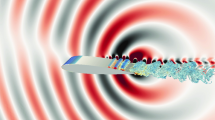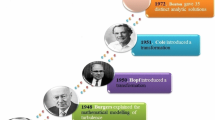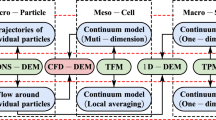Abstract
The “double-buffer problem” has been regarded as a crucial concern for the strategy behind the hybrid large eddy simulation (LES)/Reynolds-averaged Navier–Stokes (RANS) model (or HLR model, for short). Such models are likely to show unphysical mean-velocity distributions in the LES–RANS interface region, where “super-streak structures” also appear that look like low-speed streaks generated in the near-wall region of wall turbulence. To overcome this difficulty, the stochastic backscatter model, in which the vortex structures in the interface region are divided into smaller scales, holds promise due to the effect of random source term imposed in the momentum equation. Although this method is effective, several parameters must be prescribed and their specification process is arbitrary and ambiguous. An alternative advanced HLR model has been proposed, in which an anisotropy-resolving subgrid-scale (SGS) model was adopted in the LES region as well as a one-equation nonlinear eddy viscosity model in the RANS region. Previous investigations indicated that this HLR model did not exhibit or, at least, largely reduced the “double-buffer problem” in the mean-velocity distribution, with no special treatment being applied. The main purpose of the present study is to reveal why this HLR model improves the predictive performance in the LES–RANS interface region. Specifically, we focus on the role of the extra anisotropic term introduced in the SGS model, finding that it plays an important role in enhancing vortex structures in the interface region, leading to a considerable improvement in model performance.
Similar content being viewed by others
References
Smagorinsky, J.: General circulation experiments with the primitive equations. I. The basic experiment. Mon. Weather Rev. 91, 99–164 (1963)
Germano, M., Piomelli, U., Moin, P., Cabot, W.H.: A dynamic subgrid-scale eddy viscosity model. Phys. Fluids A 3, 1760–1765 (1991)
Lilly, D.K.: A proposed modification of the Germano subgrid-scale closure method. Phys. Fluids A 4, 633–635 (1992)
Zang, Y., Street, R.L., Koseff, J.R.: A dynamic mixed subgrid-scale model and its application to turbulent recirculating flows. Phys. Fluids A 5, 3186–3196 (1993)
Horiuti, K.: A new dynamic two-parameter mixed model for large-eddy simulation. Phys. Fluids 9, 3443–3464 (1997)
Morinishi, Y., Vasilyev, O.V.: A recommended modification to the dynamic two-parameter mixed subgrid scale model for large eddy simulation of wall bounded turbulent flow. Phys. Fluids 13, 3400–3410 (2001)
Balaras, E., Benocci, C., Piomelli, U.: Two-layer approximate boundary conditions for large-eddy simulations. AIAA J. 34, 1111–1119 (1996)
Nikitin, N.V., Nicoud, F., Wasistho, B., Squires, K.D., Spalart, P.R.: An approach to wall modeling in large-eddy simulations. Phys. Fluids 12, 1629–1632 (2000)
Hamba, F.: An attempt to combine large eddy simulation with the \(k\)-\(\varepsilon \) model in a channel-flow calculation. Theor. Comput. Fluid Dyn. 14, 323–336 (2001)
Davidson, L., Peng, S.H.: Hybrid LES-RANS modelling: a one-equation SGS model combined with a \(k\)-\(\omega \) model for predicting recirculating flows. Int. J. Numer. Methods Fluids 43, 1003–1018 (2003)
Batten, P., Goldberg, U., Chakravarthy, S.: Interfacing statistical turbulence closures with large-eddy simulation. AIAA J. 42, 485–492 (2004)
Hanjalic, K., Hadziabdic, M., Temmerman, L., Leschziner, M.A.: Merging LES and RANS strategies: zonal or seamless coupling? In: Friedrich, R., et al. (eds.) Direct and Large Eddy Simulation V, pp. 451–464. Kluwer Academic Publishers, Dordrecht (2004)
Temmerman, L., Hadziabdic, M., Leschziner, M.A., Hanjalic, K.: A hybrid two-layer URANS-LES approach for large eddy simulation at high Reynolds numbers. Int. J. Heat Fluid Flow 26, 173–190 (2005)
Spalart, P.R., Deck, S., Shur, M.L., Squires, K.D., Strelets, MKh, Travin, A.: A new version of detached-eddy simulation, resistant to ambiguous grid densities. Theor. Comput. Fluid Dyn. 20, 181–195 (2006)
Breuer, M., Jaffrezic, B., Arora, K.: Hybrid LES/RANS technique based on a one-equation near-wall model. Theor. Comput. Fluid Dyn. 22, 157–187 (2008)
Deck, S.: Recent improvements in the Zonal Detached Eddy Simulation (ZDES) formulation. Theor. Comput. Fluid Dyn. 26, 523–550 (2012)
Abe, K.: A hybrid LES/RANS approach using an anisotropy-resolving algebraic turbulence model. Int. J. Heat Fluid Flow 26, 204–222 (2005)
Piomelli, U., Balaras, E., Pasinato, H., Squires, K.D., Spalart, P.R.: The inner-outer layer interface in large-eddy simulations with wall-layer models. Int. J. Heat Fluid Flow 24, 538–550 (2003)
Abe, K.: An advanced switching parameter for a hybrid LES/RANS model considering the characteristics of near-wall turbulent length scales. Theor. Comput. Fluid Dyn. 28, 499–519 (2014). https://doi.org/10.1007/s00162-014-0328-3
Abe, K.: An improved anisotropy-resolving subgrid-scale model with the aid of a scale-similarity modeling concept. Int. J. Heat Fluid Flow 39, 42–52 (2013)
Uruma, O., Kihara, H., Abe, K.: An improvement of hybrid LES/RANS model for complex turbulence with the aide of an anisotropy-resolving subgrid-scale model. In: Proceedings of the 29th International Symposium on Space Technology and Science, Nagoya, Japan, Paper No. 2013-e-18, June 2–9 (2013)
Abe, K.: An investigation of SGS-stress anisotropy modeling in complex turbulent flow fields. Flow Turbul. Combust. 92, 503–525 (2014)
Ohtsuka, T., Abe, K.: On the role of an anisotropy-resolving extra term for a subgrid-scale model in near-wall turbulence. J. Comput. Sci. Technol. 7, 410–425 (2013)
Abe, K., Ohtsuka, T.: On the effect of an anisotropy-resolving subgrid-scale model on turbulent vortex motions. In: Proceedings of the 10th International Symposium on Engineering Turbulence Modelling and Measurements, Marbella, Spain, Paper No. S4-1, Sep. 17–19 (2014)
Bardina, J., Ferziger, J.H., Reynolds, W.C.: Improved subgrid scale models for large eddy simulation, AIAA Paper, No. 80-1357 (1980)
Inagaki, M.: A new wall-damping function for large eddy simulation employing Kolmogorov velocity scale. Int. J. Heat Fluid Flow 32, 26–40 (2011)
Abe, H., Kawamura, H., Matsuo, Y.: Surface heat-flux fluctuations in a turbulent channel flow up to \(Re_\tau =1020\) with Pr = 0.025 and 0.71. Int. J. Heat Fluid Flow 25, 404–419 (2004)
Muto, M., Tsubokura, M., Oshima, N.: Negative Magnus lift on a rotating sphere at around the critical Reynolds number. Phys. Fluids 24, 014102 (2012)
Kim, J., Moin, P.: Application of a fractional-step method to incompressible Navier–Stokes equations. J. Comput. Phys. 59, 308–323 (1985)
Amsden, A.A., Harlow, F.H.: A simplified MAC technique for incompressible fluid flow calculations. J. Comput. Phys. 6, 322–325 (1970)
Rhie, C.M., Chow, W.L.: Numerical study of the turbulent flow past an airfoil with trailing edge separation. AIAA J. 21, 1525–1532 (1983)
Rajamani, B., Kim, J.: A hybrid filter approach to turbulence simulation. Flow Turbul. Combust. 85, 421–441 (2010)
Germano, M.: Properties of the hybrid RANS/LES filter. Theor. Comput. Fluid Dyn. 17, 225–231 (2004)
Lee, M., Moser, R.D.: Direct numerical simulation of turbulent channel flow up to \(Re_\tau = 5200\). J. Fluid Mech. 774, 395–415 (2015)
Abe, K., Kondoh, T., Nagano, Y.: On Reynolds stress expressions and near-wall scaling parameters for predicting wall and homogeneous turbulent shear flows. Int. J. Heat Fluid Flow 18, 266–282 (1997)
Abe, K., Kondoh, T., Nagano, Y.: A new turbulence model for predicting fluid flow and heat transfer in separating and reattaching flows—I. Flow field calculations. Int. J. Heat Mass Transf. 37, 139–151 (1994)
Abe, K., Jang, Y.J., Leschziner, M.A.: An investigation of wall-anisotropy expressions and length-scale equations for non-linear eddy-viscosity models. Int. J. Heat Fluid Flow 24, 181–198 (2003)
Author information
Authors and Affiliations
Corresponding author
Additional information
Communicated by Philippe Spalart.
Rights and permissions
About this article
Cite this article
Abe, Ki. Improvement of double-buffer problem in LES–RANS interface region by introducing an anisotropy-resolving subgrid-scale model. Theor. Comput. Fluid Dyn. 32, 263–283 (2018). https://doi.org/10.1007/s00162-018-0453-5
Received:
Accepted:
Published:
Issue Date:
DOI: https://doi.org/10.1007/s00162-018-0453-5




